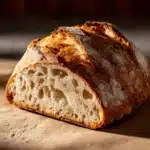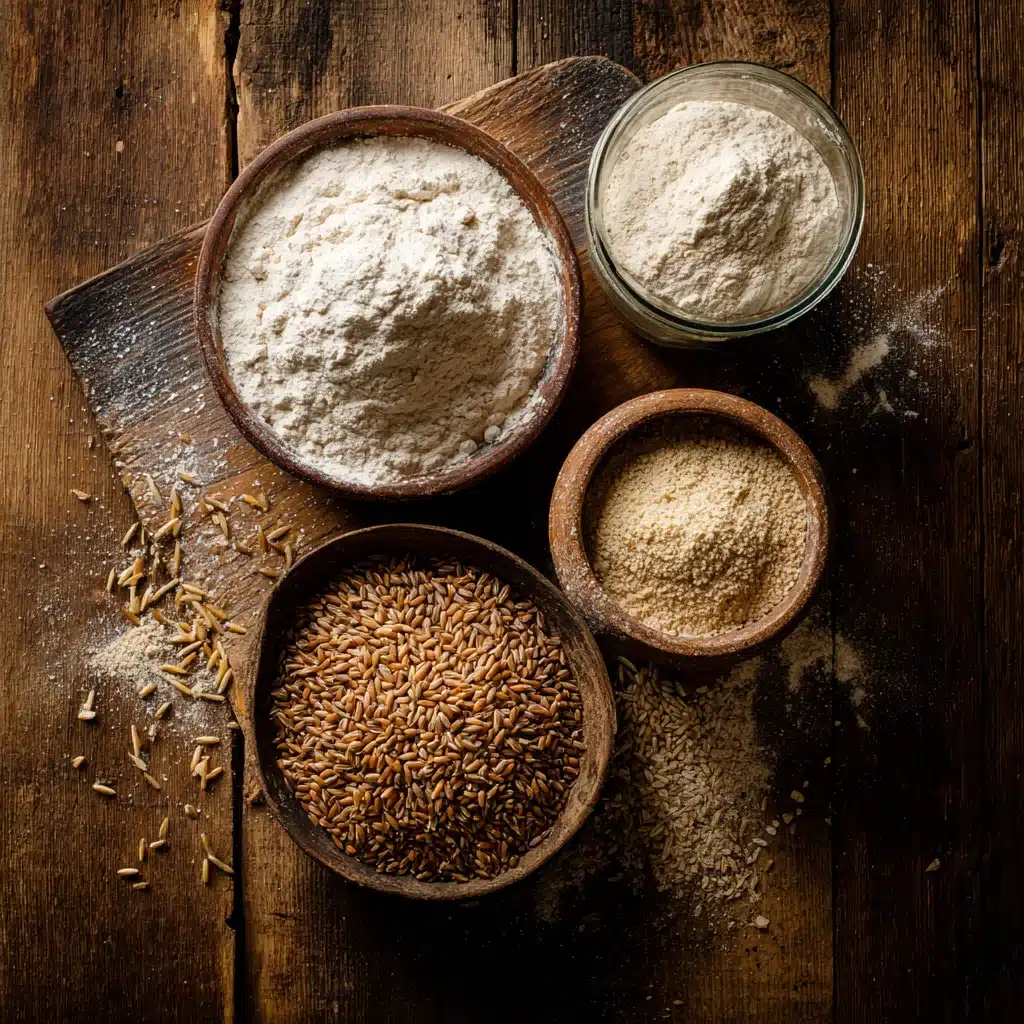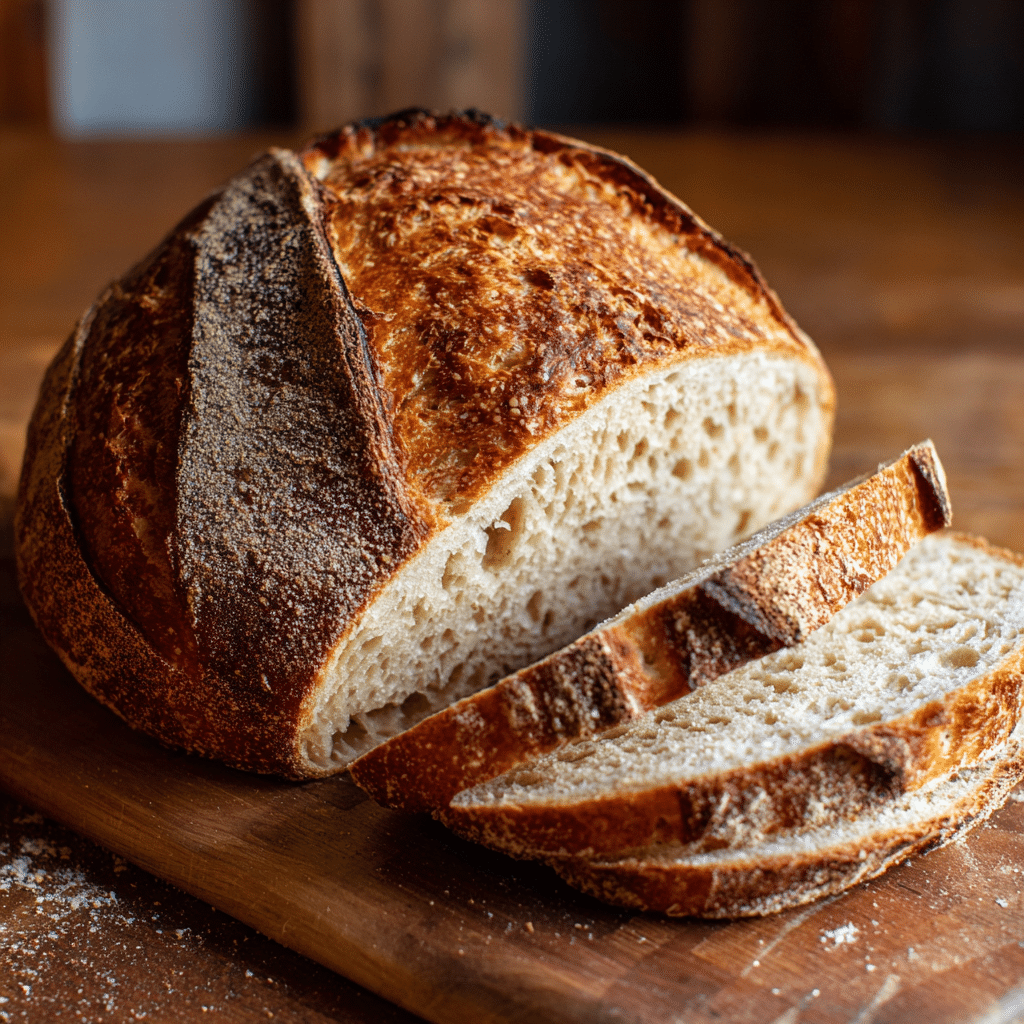If you’ve heard the term bolted flour in sourdough bread and wondered what makes it different, you’re not alone. Bolted flour strikes a beautiful balance, capturing the depth of whole grain with the lightness of sifted flour. In this article, we’ll explore what bolted flour is, how it transforms sourdough baking, what ingredients to avoid, and how to handle common baking questions like overproofing. Whether you’re experimenting with high-extraction flour or choosing between rye and unbleached flour, this guide will help you build flavor, structure, and confidence in your next loaf.
The Story & Introduction to Bolted Flour in Sourdough Bread
A sourdough story that started with sifted dreams
When I first heard the phrase bolted flour in sourdough bread, I imagined something fast, like “bolting” a loaf into the oven. But during one foggy Mendocino morning, I stumbled into its meaning slowly. I had sifted some stone ground whole wheat flour through a vintage sieve I found at a flea market, unknowingly creating bolted flour, flour with the coarsest bran removed.
That act changed everything. The loaf that followed had depth from the grain but rose like a white-flour dream. It tasted rustic yet tender. That’s when I realized that bolted flour in sourdough bread gives you the best of both worlds: character and lift. Since then, it’s become a staple in my kitchen and workshops at Marlene & Crumb.
People often ask: “Is bolted flour just sifted flour?” or “Why not use all-purpose?” Here’s the magic, bolted flour in sourdough bread has better fermentation, open crumb, and bold flavor without making the dough dense or dry. It’s forgiving for beginners, yet dynamic enough for artisan-level bakers.
If you’re exploring sourdough or refining your craft, bolted flour is your secret weapon. We break it down in our high-extraction flour guide and in this deep dive into hydration and crumb. Whether you’re baking to nourish or impress, understanding the role of bolted flour in sourdough bread will elevate your next loaf.
Print
Bolted Flour in Sourdough Bread: 3 Reasons Bakers Swear by This Powerful Upgrade
- Total Time: 16 hours
- Yield: 1 loaf 1x
- Diet: Vegetarian
Description
Sourdough bread made with bolted flour brings out bold flavor, a rustic crumb, and balanced fermentation. This version uses high-extraction flour for better oven spring and a rich texture.
Ingredients
3 cups bolted flour (high-extraction)
1/2 cup whole wheat flour
1/4 cup rye flour
1 tbsp active sourdough starter (Clementine)
1 1/4 cups warm filtered water
1 tsp sea salt
Extra flour for dusting
Instructions
1. In a large bowl, mix starter and water until cloudy. Add all flours and stir to combine. Rest 30 minutes (autolyse).
2. Sprinkle salt over the dough. Stretch and fold 4 times, every 30 minutes for 2 hours.
3. Cover and let bulk ferment at room temperature for 4–6 hours until doubled.
4. Turn dough onto a lightly floured surface. Pre-shape gently and rest for 20 minutes.
5. Final shape the dough. Place into a floured banneton or bowl. Cover and cold proof overnight.
6. Preheat oven to 475°F. Score and bake in Dutch oven for 20 mins covered, 20 mins uncovered.
7. Cool on wire rack at least 1 hour before slicing.
Notes
To bolt your own flour, sift whole grain flour with a medium mesh strainer.
You can substitute bolted flour with 50% all-purpose + 50% whole wheat if unavailable.
Hydration may need slight adjustment depending on flour brand.
- Prep Time: 20 minutes
- Cook Time: 40 minutes
- Category: Bread
- Method: Baking
- Cuisine: American
Nutrition
- Serving Size: 1 slice
- Calories: 160
- Sugar: 0g
- Sodium: 220mg
- Fat: 1.5g
- Saturated Fat: 0g
- Unsaturated Fat: 1.2g
- Trans Fat: 0g
- Carbohydrates: 33g
- Fiber: 3g
- Protein: 5g
- Cholesterol: 0mg
Keywords: bolted flour in sourdough bread, high-extraction flour bread, rustic sourdough
What Is Bolted Flour and Why It Works in Sourdough
What is bolted flour?
Bolted flour is whole grain flour that’s been sifted, or “bolted”, to remove the largest pieces of bran, leaving behind a lighter but still nutrient-dense product. The term goes back to traditional milling, where a fine mesh or cloth was used to separate coarse particles. In today’s sourdough baking world, this flour is often labeled as high-extraction flour, sitting between whole wheat and white.
Using bolted flour in sourdough bread offers the complexity of whole grain flavor with the performance of refined flour. You get better oven spring, a more open crumb, and improved dough strength. It’s especially handy if you’re trying to strike a balance between rustic and refined baking.
You can purchase bolted flour from specialty mills or bolt your own by sifting stone-ground flour through a medium-mesh sieve. This method is featured in many of our whole grain sourdough recipes where balance matters more than purity.
Why does it matter in sourdough?
In sourdough baking, fermentation is everything, and bolted flour in sourdough bread gives you a consistent, controllable fermentation process. Unlike refined white flour, bolted flour holds on to enzymes and minerals that support strong yeast activity and deeper flavor.
The flour’s moderate bran content means it absorbs water efficiently while promoting gluten development. That translates into dough that handles well and holds shape without over-fermenting. For newer bakers especially, it offers a way to build flavor without creating a dense or bitter loaf.
Our detailed post on managing fermentation in hybrid flours explains why bolted flour strikes such a unique balance in hydration and fermentation curves.
Whether you’re after flavor, structure, or better handling, there’s no doubt that bolted flour in sourdough bread opens new doors for better baking.

Ingredients to Avoid & Common Mistakes with Bolted Flour in Sourdough
What ingredient to avoid in sourdough bread?
When working with bolted flour in sourdough bread, certain ingredients can interfere with fermentation, structure, or flavor. One key ingredient to avoid is commercial bread improvers or conditioners. These additives are formulated to boost rise in commercial white flour but can disrupt the balance of a naturally fermented dough—especially when using high-extraction or bolted flours, which already ferment faster than plain white flour.
Another ingredient to watch out for? Bleached flour. It lacks the enzymes and minerals needed to support wild yeast, making it incompatible with sourdough fermentation. It also undermines the nutritional integrity bolted flour brings to the table.
Excessive sweeteners like honey or molasses can also accelerate yeast activity unpredictably. While a teaspoon here or there may be fine, more than that can overpower the grain flavor and throw off your rise.
If you’re new to balancing ingredients, our guide to mistakes beginners make with sourdough starters covers common pitfalls to help you troubleshoot doughs made with any flour—including bolted.
Common mistakes with bolted flour in sourdough bread
Using bolted flour in sourdough bread may feel straightforward, but some missteps can throw your bake off track. One of the most common is assuming it acts exactly like all-purpose or white flour. Because bolted flour absorbs slightly more water, you may need to adjust hydration by 2–5%. Too little water and the dough tightens; too much and it slackens quickly.
Another mistake is skipping the autolyse phase. Since bolted flour still contains parts of the bran and germ, allowing it to rest after mixing flour and water helps soften the remaining fiber and improves extensibility.
Overproofing is also more common with bolted flour, especially in warmer kitchens. The mineral-rich content can speed up fermentation, so you’ll need to watch your dough more than your timer. If you do overproof, resist the urge to panic. You can gently reshape and add a light dusting of flour to help firm it back up—more on that in the next section.
We dive deeper into this in our article on rescuing overproofed sourdough, including tips for reshaping and recovering flavor.

How to Fix Overproofed Dough & Bolting Your Own Flour at Home
Can I add flour to overproofed sourdough?
Overproofing happens to the best of us, even pros. When your dough has fermented too long and starts to collapse or spread out, all is not lost. If you’re using bolted flour in sourdough bread, you actually have more recovery options than if you were working with delicate white dough.
Yes, you can add flour to overproofed sourdough, but carefully. Lightly dust the surface and gently reshape the dough to build tension. Don’t knead it again, or you’ll degas it too much. Using a bit of bolted or unbleached flour helps firm up the surface while keeping that nutty, rustic character intact.
Another effective fix: place the reshaped dough in a banneton or small bowl and chill it in the fridge for 30–60 minutes. The cooler environment slows yeast activity and strengthens the dough structure. This short rest allows you to recover oven spring, especially when paired with a preheated Dutch oven.
If this happens often, revisit your fermentation timing. We explain this in our guide to fermentation schedules for sourdough, a helpful read if you’re managing varied flours like bolted, rye, or whole wheat blends.
How to bolt your own flour at home
If you’ve ever wanted to experiment with bolted flour in sourdough bread, you don’t have to wait for a specialty bag from a mill. You can bolt your own flour right at home with just two tools: stone ground whole wheat flour and a medium or fine mesh sieve.
Here’s how:
- Scoop 1–2 cups of whole wheat flour into your sieve.
- Shake or tap the sieve gently over a large bowl.
- The fine flour that falls through is your bolted flour.
- The bran left in the sieve can be saved for porridge or compost.
This process removes the roughest particles but leaves behind flavorful oils and nutrients. You now have homemade high-extraction flour, perfect for sourdough that’s structured yet still hearty.
Want to go deeper? Our step-by-step bolting guide walks you through sifting ratios, mesh sizes, and hydration adjustments when working with bolted flour.
Experiment with different grain bases, like rye flour or spelt, and test how each bolts differently. Keep a flour log to track your results and adjust hydration. It’s all part of the joy of sourdough, where observation, adjustment, and trust in your hands matter more than perfection.

Conclusion
Baking with bolted flour is more than just a method, it’s a practice rooted in balance and depth. You get the hearty richness of whole grain, but with the performance and versatility of sifted flour. Whether you’re buying a high-extraction blend or bolting your own at home, this approach opens up a whole new world in your sourdough journey.
It supports consistent fermentation, a resilient crumb, and enhanced flavor, all with a beautiful open structure. Best of all, you don’t need fancy tools. A simple sieve and quality flour are enough to start baking loaves that feel nourishing and taste memorable.
Want to take your skills even further? Explore our complete sourdough library or browse our flour and dough hydration tips to fine-tune your next bake.
Sourdough isn’t about perfection—it’s about feeling, patience, and flour that honors both tradition and flavor. And that’s exactly what bolted flour brings to the table.
Frequently Asked Questions
What ingredient should I avoid in sourdough bread?
Avoid bleached flour, which lacks the nutrients and enzymes needed for healthy fermentation. Also, skip chemical dough enhancers or excessive sugars—they can throw off balance when using more complex flours like high-extraction or sifted blends.
What is bolted bread flour?
It’s a type of flour made by sifting whole grain to remove large bran particles, leaving behind a flour that’s lighter than whole wheat but richer than white. Bakers love using this flour for structure, flavor, and flexibility in naturally leavened doughs.
Can I add flour to overproofed sourdough?
Yes. Lightly dusting with bolted or unbleached flour can help reshape a dough that’s gone too far. Chill it before baking to recover some structure. Avoid re-kneading, which will collapse the crumb.
What is bolting flour?
Bolting is the traditional method of sifting coarse milled flour to create a smoother, more manageable blend. This flour type is ideal for bakers who want the flavor of whole grain with the performance of lighter flours—perfect for sourdough baking.
for more recipes followo me in pinterest

